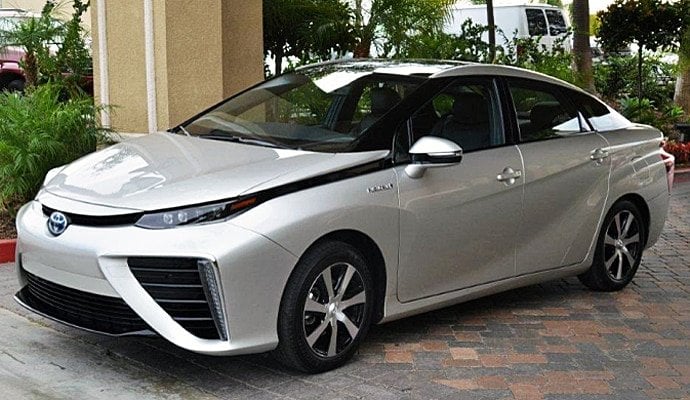
If a hydrogen car is operated with green hydrogen, it requires about 2.4 times the energy of a classic electric car, according to Professor Manfred Schrödl of TU Vienna. He does not consider hydrogen to be a viable energy source for individual passenger transport.
The discussion about hydrogen cars versus electric cars is still going on. In Austria, former Federal Chancellor Sebastian Kurz heated up the debate when he recently announced that his party, the Austrian People’s Party, wanted to make Austria the number one hydrogen nation. Part of the strategy was to cover the entire country with hydrogen refueling stations by 2025.
Reducing mobility emissions
A few months earlier, the media had reported that Austria would not reach its climate targets and would have to reckon with high fines. The country has pledged to pay the fines for the following targets from 2005 to 2030:
- reduce CO2 emissions by 36%;
- meet the annual average electricity demand using renewable sources by 100%;
- reduce emissions in the mobility sector by a third;
As regards to Kurz’s proposed strategy, it should be noted that to date there are no more than five hydrogen refueling stations in Austria. The hydrogen that is available there is largely produced from natural gas, a fossil fuel. It therefore seems unlikely that hydrogen technology will catch up with climate targets within ten years.
Hydrogen car vs. electric car
Professor Schrödl from the Research Institute for Energy Systems and Electric Drives at the Vienna University of Technology has looked at the figures and clearly rejects hydrogen technology for private passenger transport. Instead, he calls for the promotion of electromobility and higher subsidies for renewable energies – photovoltaics in particular.
When Schrödl talks about the hydrogen car, he is referring to a car that runs on hydrogen. The hydrogen is fed into a fuel cell where it oxidizes into water. The energy that is released is generated as electricity which is used to drive electric motors. Water is the only by-product.
The electric car is also driven by an electric motor, but draws its electrical energy from a traction battery. It emits no significant pollutants during operation and is classified as an emission-free vehicle.
Energy balance of green fuels
In an ideal scenario, Schrödl bases his calculations on green fuel and takes into account the energy input from wind turbines or photovoltaic systems. The result? An electric car needs approximately 22 kilowatt hours (kWh) for a journey of 100 kilometers, a hydrogen car 52 kWh. The balance for the hydrogen car is consequently much worse. This needs around 2.4 times more energy than an electric car.
| km | kWh | |
| Electric car |
100 | 22 |
| Hydrogen car |
100 | 52 |
For electric cars, Schrödl adds ten percent energy loss due to intermittent storage and charging, including a value of 2 kWh.
For hydrogen cars, it starts with the extraction by electrolysis, compression to 700 bar as well as transport. The resulting loss is calculated as between 13 and 19 kWh.
Energy balance of neutral hydrogen
However, this ideal scenario is not applicable in practice. According to Schrödl, over 90 percent of hydrogen is currently produced from natural gas, a fossil fuel. With an efficiency level of approximately 66 percent, the production of this so-called neutral hydrogen is inefficient from an energy perspective. CO2 is also produced. In addition to the losses incurred due to compression and transport, the researcher calculates a primary energy consumption of 62 kWh for every 100 kilometers of travel calculated on the basis of natural gas production.
“A hydrogen car powered by fossil fuels is no better than a normal combustion car with a fuel consumption of 6 to 7 liters of petrol or diesel per 100 kilometers.” Manfred Schrödl.
Increased production of renewable energy
In Austria, the annual consumption of electrical energy is currently around 70 terawatt hours (TWh). Of these about:
- 20 TWh comes from fossil thermal power plants;
- 40 TWh comes from hydropower;
- 10 TWh comes from other renewable sources such as wind, photovoltaics or biomass;
By 2030, the demand for electricity is expected not only to rise from 70 to 80 TWh , but also 100 percent for renewable sources. Electricity production from renewable sources must therefore be increased by 30 TWh over the next ten years. “Achieving this goal is in principle technically possible, but it requires strong political will,” says Schrödl.
Costly hydrogen initiative
Not included in these calculations as yet is the green hydrogen initiative using renewable electricity. According to Schrödl, an additional 22 TWh of electrical energy will be required if the targeted reduction by a third – around ten million tonnes – in petrol and diesel consumption is to be achieved. This would mean the expansion of renewable energy from 30 TWh to 2030.
It would be considerably more efficient to reduce diesel and petrol consumption by expanding battery-based electric mobility. This would lead to just 9 TWh of additional electrical energy.
In any case, the expansion of renewable energies will require subsidies. The researcher puts this figure at around 250 million euros per year for photovoltaics alone – the output of which would have to be increased five-fold. According to Schrödl, this is money that would otherwise be spent later on fines for excessively high CO2 emissions.
The future of hydrogen technology
Even if Schrödl rejects green hydrogen in private passenger transport, he does not categorically reject it. Rather, he sees a future for hydrogen in areas such as long-term energy storage or in industry, where the resulting heat waste could also be used optimally.
More articles about electromobility HERE
More articles about fuel cells HERE
